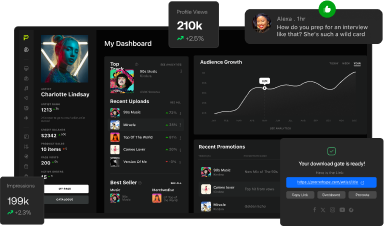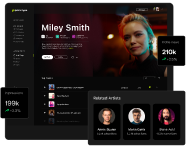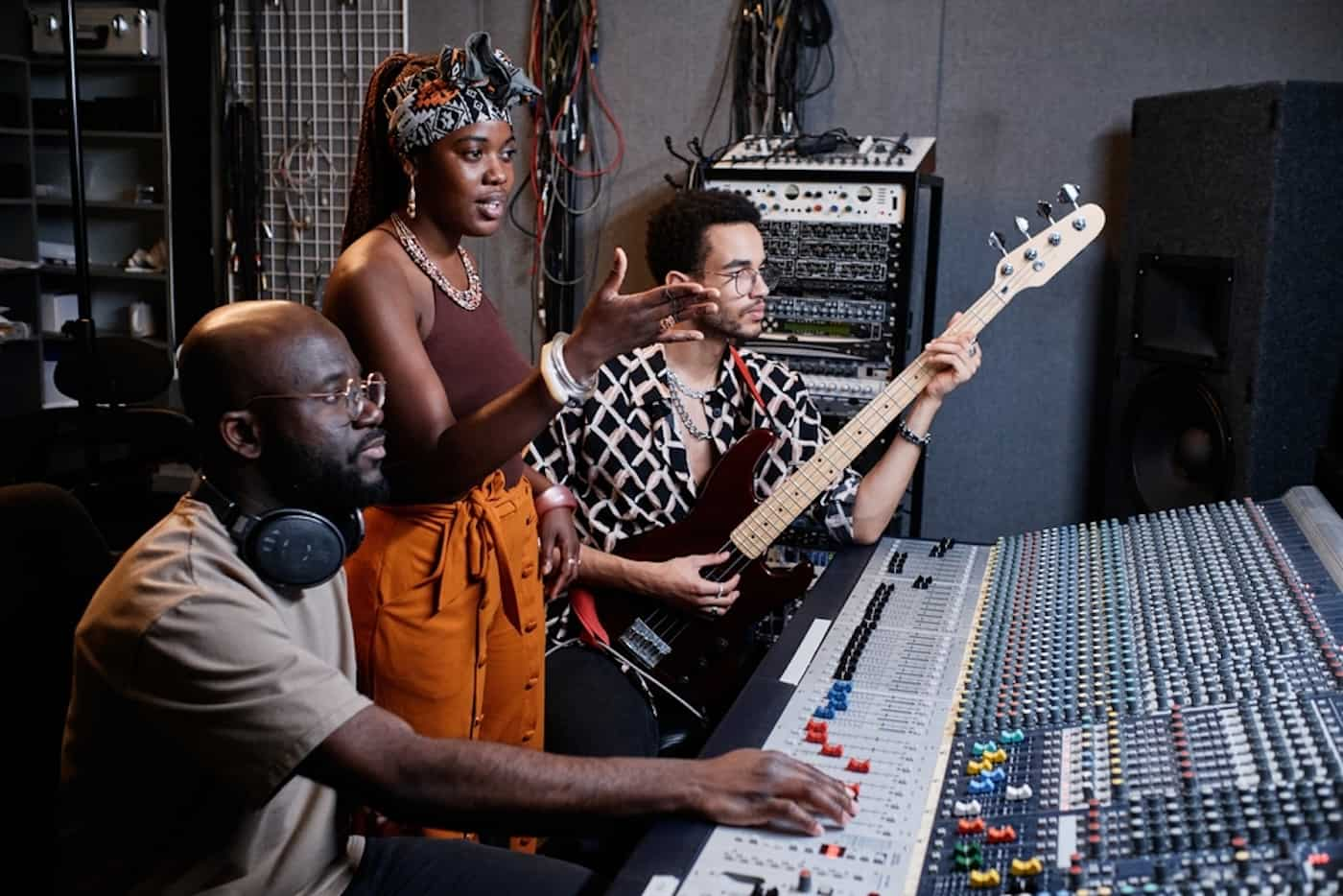
Mechanical royalties offer artists and songwriters a reliable source of income, but they’re also often confusing and opaque.
By understanding how mechanical royalties work, you can incorporate them into your overall revenue strategy and gather the income you deserve.
This guide explores mechanical royalties for music creators, covering how they function, who gets paid, and resources you can use.
Get Early Access
To Promo Hype
What Are Mechanical Royalties?
Mechanical royalties fit into a broader scope of music royalties and were traditionally based on the reproduction of music in physical media.
This includes the mechanical reproduction of music on CDs and vinyl records, with payments made to artists based on sales.
The payment of mechanical royalties is based on who made the music’s composition, as opposed to the owner of the sound recording.
Today, mechanical royalties have been extended to include forms of online sales, including plays on streaming services and digital downloads.
This changing landscape has seen the rise of various music royalties platforms, often with the backing of major artists.
How Do Mechanical Royalties Work?
We’ve touched on the basics of mechanical royalties and how payments are made based on physical sales, digital downloads, and streams.
The copyright owners of a given piece of music, including independent artists and music publishers, impact this structure.
Copyright for music is broken into two main categories, with one copyright for the composition and another for the sound recording.
As a rule, the individual songwriters responsible for writing a song are the primary recipients of most mechanical royalties.
However, if the songwriters have signed a publishing deal, their publishers may take responsibility for registering and collecting payments.
This can include checking rates with the Copyright Royalty Board and registering with organizations like the Mechanical Licensing Collective.
Read more: How to become a music producer.
Mechanical Royalties Vs. Performance Royalties
Of all the types of royalties, mechanical royalties and performance royalties are the most commonly collected by artists.
That’s why it’s essential to understand the differences between the two models to ensure optimal royalty collection across all media.
Perhaps the key difference in performance royalties is the general source, with a focus on public performance and broadcasting.
If your music is played on the radio or used in a TV show or movie, songwriters and publishers will receive performance royalties.
Additionally, performance royalties are paid whenever copyrighted music is played in venues such as restaurants, bars, and clubs.
Collecting performance royalties also works differently, with ASCAP and BMI being two notable organizations for this task.
By understanding these distinctions, artists can promote their music across multiple platforms and collect optimal music royalties.
Mechanical Royalties, Performance Royalties, & Streaming Services
One area where there is overlap between mechanical royalties and performance royalties is in how they relate to streaming services.
Both of these royalty types can be triggered when music is streamed on platforms like Spotify, which can create confusion.
This is because streaming music is considered to be both a public performance and a mechanical reproduction.
When this occurs, royalties are paid for both mechanical royalties and performance royalties, provided both have been set up.
Who Can Collect Mechanical Royalties?
We’ve touched briefly on the relationship between songwriters and publishers when it comes to getting mechanical royalties paid out.
Most artists and labels use Mechanical Rights Organizations to handle the licensing of music and the collection of related royalties.
To use these services, artists or publishers will register works with the relevant MRO and split revenue based on prior agreements.
In the USA, there’s the Mechanical Licensing Collective, which focuses on music distributed across digital streaming services.
For independent artists, digital music distribution services often include tools to ensure royalties are paid promptly to their members.
You can also learn how to trademark a band name to protect further your brand, including logos and other visual assets in the process.
How Mechanical Royalties Are Paid
Now that we’ve covered the types of mechanical royalties and the various methods of collection, let’s explore how they’re paid.
While the process varies depending on whether it relates to streaming royalties or sales of physical formats, the core steps are as follows:
- The piece of music is reproduced as physical albums or singles on CD or vinyl records, or uploaded for distribution on streaming services.
- Based on the number of copies sold or downloaded, the mechanical royalties are calculated in line with the pre-determined payment structure.
- Once the MRO has made this calculation, royalties are paid to the songwriters or publishers through direct deposits on a monthly or quarterly basis.
- If the songwriters have received advanced royalties from publishers, payments will be used to recoup these costs from the publisher.
- Royalty statements are then created outlining collections, deductions, and amounts distributed between each party.
It’s essential to understand how this arrangement can vary depending on the platform and any contract made with music industry publishers.
Learn more: How to make money as a music producer.
Rates For Paid Mechanical Royalties
The rates paid for mechanical royalties can vary depending on the source or platform through which it is presented to audiences.
Here’s an overview of how mechanical royalties are paid based on streaming services, digital downloads, and physical sales.
Mechanical Royalties From Streaming Services
Streaming royalties often make up the bulk of royalties for artists, particularly when collected across multiple platforms.
Also known as on-demand or interactive streaming, these platforms cover all of the most popular music genres along with small niches.
As we’ve touched on earlier, whenever music is streamed on such platforms, both mechanical royalties and performance royalties are eligible.
For mechanical royalties based on streaming services, the rate of pay varies between platforms, with an average of around $0.06 per 100 streams.
In terms of payment rates per individual stream, different platforms offer various rates, including:
- Spotify: Approximately $0.00437 per stream.
- Apple Music: Approximately $0.01 per stream.
- Tidal: Approximately $0.01284 per stream.
- YouTube (Official Artist Channels): Approximately $0.00069 per stream.
- Amazon Music: Approximately $0.00402 per stream.
Payout amounts can vary depending on the listener’s location, their subscription status to premium memberships, and other factors.
Understanding this variability of rates helps artists to assess which offers fair market value and plan their uploads accordingly.
It’s also important to factor in performance royalties if activated, since this revenue impacts the final royalty split.
Mechanical Royalties From Digital & Physical Sales
Additional income from mechanical royalties can be gained through digital downloads and physical sales of CDs and vinyl records.
Many of the best music producers of all time have earned significant sums through physical media sales and topping the Billboard charts.
While streaming royalties are frequently accumulated, their small individual amount can make it challenging to generate a decent revenue stream.
Digital downloads are more lucrative, with mechanical royalties paying approximately 9.1 cents for each song sold as a download.
Mechanical royalties for CD and vinyl sales are also a higher percentage, with rates of 8.5% or higher not uncommon in the music industry.
In the United States, the Mechanical Licensing Collective is the go-to society for collecting royalties from physical media sales.
Some factors that can impact mechanical royalties through physical sales include:
- The record company sales price of the item, also known as the “dealer price,” will influence decisions surrounding royalty rates.
- Any terms and conditions between the artist and publisher, such as advance payments and shares of ownership.
- The number of units sold, with potential bonuses for surpassing pre-established sales figures.
- Where the physical media is sold, and any related shipping costs or local regulations that impact the retail price and profit margin.
Artists should also be mindful of royalty rates concerning inflation, with the former consistently lagging behind the latter in recent years.
Get Early Access
To Promo Hype
Mechanical Royalties & Publishing Agreements
Partnering with a music publisher is an excellent way to gain access to marketing resources and get music submitted to radio stations.
The topic of mechanical royalties and how they relate to publishing agreements includes various factors that artists must consider.
Before signing a contract with music publishers, factor in the following considerations:
Artist Advances & Publishing Agreements
In a typical agreement with music publishers, the songwriter hands over 100% of the copyright and royalty collection rights.
This excludes the writer’s share of the income from public performance, with the publisher and artist splitting revenue on a 50/50 basis.
If the songwriters have taken an advance on the royalties, their 50% share will be dedicated to recouping the advance payment.
Once this has been recouped, they are then able to collect ongoing royalties at the pre-arranged rate moving forward.
Co-Publishing Agreements
Another common approach to music publishing is through a co-publishing agreement, which offers an exception to the 50/50 split.
Here, both the songwriters and publishers own half of the song’s copyright, which increases the writer’s share to an overall 75%
This is due to the writer’s dual role as a writer and publisher, allowing them to take an additional 25% of the publishing share.
Controlled Composition Clauses
In some deals between an artist and a record label, the label receives a discount on mechanical royalties owed to the songwriter.
A controlled composition clause allows the label to lower the rate to 75% of the statutory rate and limit songs subject to this rate.
While unenforceable regarding mechanical royalties from streaming, this can significantly impact an artist’s royalties from physical sales.
This makes negotiation a must, ensuring as limited a reduction of royalties as possible for all writers of a given song.
Music Royalties & The Music Modernization Act
The Music Modernization Act, passed in 2018, provided a series of notable updates to how the music industry manages royalties.
Designed as a blanket license, the Music Modernization Act streamlines the licensing and payment of music for streaming services.
The result is a direct flow of royalties through the Music Licensing Collective (MLC) and its complete administration of mechanical royalties.
Thanks to the creation of a centralized copyright database, rights holders can be easily located and paid their owed royalties.
The process also simplifies the process of claiming “black box” royalties, which previously was problematic due to incomplete registrations.
Music created before 1972 was also protected through the Classics Protection and Access Act, helping established artists retain revenue.
Mechanical Royalties & International Distribution
Music sales are an international business, but global distribution also creates complications when collecting mechanical royalties.
This means approaching international mechanical royalties on a case-by-case basis, registering with the regional collection society.
Different countries have their own society for mechanical and public performance royalties, as well as differing rates.
Recently, the Mechanical Licensing Collective has enrolled over 100 indie distributors from 20 countries to help streamline the process.
It has been designed to serve as a highly efficient portal to help songwriters collect mechanical royalties from multiple sources.
Distributors can access a range of publicly available data, simplifying how unmatched royalties are identified and claimed.
Recommended read: Find out how to get signed to a record label.
Alternatives To Mechanical Royalties
Mechanical royalty payments are frequently used in the music industry to help artists maximize their income, but other royalties are also available.
In addition to performance royalties discussed above, here are other types of royalties you can access:
- Synchronization royalties: Synchronization royalties, also called sync licensing, are when songs are used in visual media, such as movies, TV shows, and video games. You can
- Print royalties: Print royalties are generated whenever a piece of sheet music is sold, paying out to the creator of the musical composition. While not as lucrative or standard as mechanical royalties and performance royalties, print royalties can be worth considering for specific genres of music.
- Direct licensing: If you’d prefer to bypass mechanical royalties organizations entirely, you can consider direct licensing with music users. This includes entering into negotiations with the source and cutting out the middleman to streamline the process.
Exploring these and other monetization options ensures your revenue is optimized above and beyond collecting mechanical royalties.
Mechanical Royalty Tips
Optimizing the mechanical royalties paid out for your creative efforts can be a challenge, especially if you lack experience.
Here are some tips to help maximize your mechanical royalties across music streaming and sales of physical albums and singles:
- Register with multiple organizations: There are several organizations available for registering songs, and using one mechanical collection society can limit your income. Instead, register with various societies to increase your overall mechanical royalty rates worldwide.
- Optimize your metadata: By optimizing your song’s metadata and ensuring accuracy, proper tracking is ensured, ensuring mechanical royalties are paid based on correct information.
- Negotiate your splits with publishers: If you’re working with major music publishers, take the time to negotiate the best possible deal for splitting revenue from mechanical royalties. Alternatively, using a digital music distribution service for independent artists can often be beneficial, allowing you to retain 100% of royalties earned.
- Promote your music online and offline: Using a dedicated artist website and social media can significantly improve your streams and downloads. Likewise, getting gigs as a musician can also drive attention to your music and increase your mechanical royalties.
The more opportunities you seize to promote your music, the higher the traffic to streaming services and downloads will become.
Read next: The best music equipment for beginners.
Mechanical Royalties Resources
Artists and music producers have a wealth of valuable resources to help with everything from music production tips to generating revenue.
This includes many resources to assist with mechanical royalties, from collection societies to royalty calculators and much more.
Here are some excellent resources to help you optimize your mechanical royalties across all platforms:
- The Mechanical Licensing Collective: If you’re based in the United States, the Mechanical Licensing Collective is the primary source you need to use. You can also use it to find out more information regarding statutory rates and licensing information that can help your collection.
- Copyright Royalty Board: The Copyright Royalty Board is another valuable resource that has helped songwriters increase mechanical royalties. They also provide access to royalty calculation tools and can help with challenges and legal disputes.
- Royalty Exchange: Musicians can use Royalty Exchange for a variety of services, including the sale of royalty streams to investors for lump-sum upfront payments. This opens up new possibilities for artists looking to generate revenue based on their work quickly.
- Billboard and Indie Music Academy: If you’re assessing the performance of charting songs and want to estimate royalties, Billboard and Indie Music Academy can help. These platforms offer calculators for determining income from streaming royalties based on specific platforms and usage.
Spend time researching each of these organizations and resources to clarify what’s expected from artists when registering their work.
Summary
Earning money from songwriting through mechanical royalties is a reliable way to acquire consistent revenue.
With mechanical royalties from streaming services and physical sales, you can optimize how your musical work generates income.
Combining mechanical royalties with performance royalties and other revenue allows you to build a successful and profitable career.
Get Early Access
To Promo Hype
Join Promo Hype






